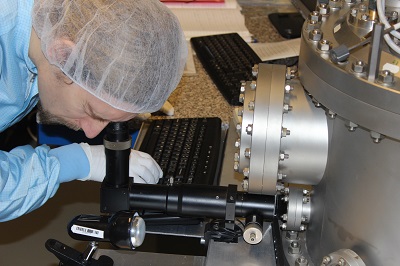e-Beam Lithography
Expression „security holograms“ covers different kinds of technologies with different security levels. The key difference between them lies in the way of creating master hologram for holograms mass printing. OPTAGLIO uses e-beam lithography for creating master holograms.
The basic principle is common for all kinds of holograms. A sensitive layer is deposited on a back-plate, bombed by beams, developed (spaces affected by beam bombing are diminished faster than the rest) and a diffracting grating is thus made to create visual effect required.
Common holograms are made through bombing sensitive layer with a concentrated light beam (laser). Resolution is limited by the light wavelength. E-beam lithography works with electron beam so than thousand times more subtle resolution can be reached.
This enables us to:
- - Create entirely new types of visual illusions. Read more.
- - Create holograms than cannot be copied at all. Traditional methods of creating holograms are useless because of nonsufficient resolution. Even an attacker equipped with e-beam Lithograph cannot copy a hologram without knowledge of mathematic algorithms used. These algorithms cannot be derived back from ready holograms.
High prices of Lithographs and knowledge-intensive nature of the technology are often identified as the key disadvantages of e-beam lithography. However, from anti-counterfeit protection point of view it is a benefit, because it is difficult for an attacker to get the technology.
We reached a resolution which enabled us to place detailed map of the Moon on one square centimeter.
OPTAGLIO has focused on e-Beam Lithography since 1998. It installed unique appliances, gathered unrivalled knowledge and is now recognized as the global market leader. It uses a shaped beam Lithograph which is more flexible than the alternative (Gauss Lithograph). It has reached resolution up to 2,5 million DPI (physical limit of common hologram is about 10 000 DPI) and patented several methods of creating holographic visual illusion.
